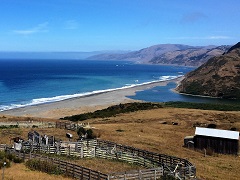Free presentation set on California Marine Protected Areas
Organization:
BLM Office:
Media Contact:
 WHITETHORN, Calif. – Information on northern California’s marine protected areas will be offered in a free presentation, Sunday, March 22, from 3 to 5 p.m., at the Healy Senior Center, 456 Briceland Road in Redway.
WHITETHORN, Calif. – Information on northern California’s marine protected areas will be offered in a free presentation, Sunday, March 22, from 3 to 5 p.m., at the Healy Senior Center, 456 Briceland Road in Redway.
Angie Edmunds, an interpreter from California State Parks, will lead the presentation describing MPAs, how they function, and how North Coast residents can help to support resilient oceans.
“As a SCUBA diver, I have personal experience with the special underwater wilderness of the North Coast, and I’m eager to share the magic of these special places,” Edmunds said. “I will include some information about Native American tribes’ involvement and roles in the MPAs and the success story of their participation and support.”
The presentation will include a screening of “Stewards of the Wild Sea,” a short film about the pivotal role of North Coast tribes in efforts to protect oceans and cultural lifeways.
Edmunds, a northern California native, has been involved over the past four years in MPA outreach and education programs, working with California State Parks, the California Department of Fish and Wildlife and the MPA Collaborative Network.
The discussion and video presentations are part of an ongoing lecture series presented by Friends of the Lost Coast (formerly the Lost Coast Interpretive Association), the Bureau of Land Management King Range National Conservation Area and the King Range Alliance.
Refreshments will be available. Additional information is available at www.lostcoast.org, or by emailing a request to [email protected].
The BLM manages about 245 million acres of public land located primarily in 12 western states, including Alaska, on behalf of the American people. The BLM also administers 700 million acres of sub-surface mineral estate throughout the nation. Our mission is to sustain the health, diversity, and productivity of America’s public lands for the use and enjoyment of present and future generations.
